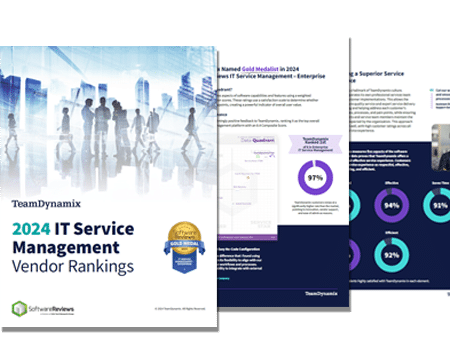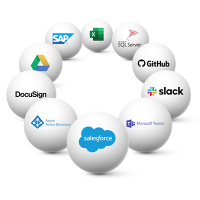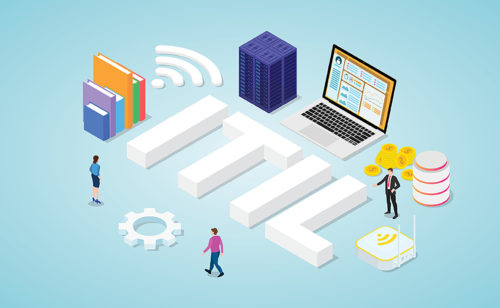
Paving the Way for Better IT Service with the Right ITSM Tool
The construction industry can be very volatile, with a high employee turnover rate due to seasonal fluctuations in the workforce. A key challenge for the

The Info-Tech ranking report offers a unique view of the market based entirely on in-depth customer interviews. Download the Info-Tech ITSM Quadrant and Customer Viewpoint report today.

We’ll show you some of our best situations and show you exactly how to execute them to get immediate results. The best part is, iPaaS tools often feature easy-to-use click and drag functionality, meaning you don’t need a dedicated employee building integrations and workflows.

System Integrators, Value Added Resellers, Technology Providers, and Buying Consortiums can benefit from a partnership with TeamDynamix.

The Info-Tech ranking report offers a unique view of the market based entirely on in-depth customer interviews. Download the Info-Tech ITSM Quadrant and Customer Viewpoint report to gain a better understanding of key vendor strengths and emerging market requirements.
Digital transformation is the integration of digital technologies into all aspects of a business, fundamentally changing how organizations operate and deliver value to customers. As businesses continue to evolve, Enterprise Service Management (ESM) has become an essential IT strategy to support this digital transformation journey.
In this blog post, we will delve into the concept of ESM, its core principles, and how it empowers departments outside IT to build their own automations and integrations, streamline service delivery processes, align tech stacks, have better security and governance over data and APIs, gain improved visibility for leadership and ultimately enhances the overall customer experience.
Enterprise Service Management is a holistic approach that extends the traditional IT Service Management (ITSM) framework to other departments within an organization, such as HR, finance or facilities. It involves the implementation of service management best practices, processes and tools across the entire enterprise, with the primary goal of delivering a seamless and efficient service experience to both internal and external customers.
The core concepts of ESM include:
ESM differs from traditional IT services in that it goes beyond the IT department, encompassing all areas of the organization to create a more unified and customer-centric approach. This makes ESM applicable to organizations across various sectors, including healthcare, education, retail, manufacturing and more.
Current industry trends such as cloud computing, artificial intelligence (AI), and the Internet of Things (IoT) have accelerated the need for ESM as an essential IT strategy. These technologies demand a more agile and integrated approach to service management, which ESM effectively addresses.
When looking for an ESM vendor, it’s important to consider features and functionality. You’ll want to find a vendor that offers an ESM platform that’s complex enough for IT’s needs but is simple enough to use outside of IT. No-code ESM platforms that combine ESM with Project Portfolio Management and integration and automation (through iPaaS) all on a single platform are ideal.
ESM distinguishes itself from traditional IT services by extending the principles of ITSM to non-IT departments. While traditional IT services focus primarily on managing IT infrastructure and providing technical support, ESM broadens the scope to include all areas of an organization.
For example, in a traditional IT service model, a request for employee onboarding might involve multiple departments, such as IT, HR and facilities. Each department may have its own systems, processes and workflows, resulting in fragmented and inefficient service delivery.
With ESM, these departments can collaborate on a shared platform, automate their respective tasks and integrate their systems. This streamlines the onboarding process, reduces delays and improves the employee experience.
In fact, HR and onboarding/offboarding are where many companies chose to start their ESM journey.
At Pima County, for example, they are using TeamDynamix to facilitate an ESM approach to service management and delivery using TeamDynamix ITSM, PPM and iPaaS on a single platform.
When it comes to onboarding new hires, the county’s goal is to have new employees arrive on day one with everything they need to get to work, “You don’t need to waste so much time when it comes to onboarding,” Mark Hayes, information technology leader, said. “It really is such a sour experience for a new hire to come in, in this day and age, and sit around for three days waiting on their computer to show up. We need to get out of that mode and iPaaS is going to help us do that.”
In addition, using iPaaS to automate offboarding will save countless hours for a process that is normally very manual and heavily audited as Pima County is a government entity.
“As a government organization we get audited by the state every year and they want to know what these stale accounts are doing sitting here,” Hayes said. “Offboarding is currently a very manual process – having to review the list from HR of people who are no longer employed with us and manually revoking their privileges from all the different systems and software and disabling their accounts. There’s absolutely no reason for that to not be automated. iPaaS is going to help us a lot with this and save us time.”
ESM is applicable across various sectors, including healthcare, finance, retail, manufacturing and more. In healthcare, for instance, ESM can facilitate the seamless exchange of patient information between departments, improve care coordination and enhance the patient experience. In finance, ESM can automate the loan approval process, integrate data from different financial systems and ensure compliance with regulatory requirements.
Several industry trends make ESM an essential IT strategy for organizations:
As discussed above, there are many different use cases for implementing ESM in an organization. Some of these include:
Enterprise Service Management is a critical component of a successful digital transformation strategy. By extending the principles of ITSM to other departments, ESM helps organizations streamline service delivery processes, empower departments outside IT to build their automation and integrations, align tech stacks, improve visibility for leadership and ultimately enhance the customer experience. As businesses continue to embrace digital transformation, ESM will play an increasingly important role in driving organizational success.
To learn more about the state of ESM check out the latest market study from TeamDynamix and InformationWeek: State of Enterprise Service Management.

The construction industry can be very volatile, with a high employee turnover rate due to seasonal fluctuations in the workforce. A key challenge for the

A study from Information Week and TeamDynamix shows companies are looking to invest in IT Service Management (ITSM) software that is simple to administer and

When it comes to improving IT Service Management (ITSM) maturity, many organizations turn to ITIL – a framework that guides users through a process-based approach
TeamDynamix’s award-winning SaaS cloud solution offers IT Service and Project Management together on one platform with enterprise integration and automation.
[email protected]
(877) 752-6196
Contact Us
